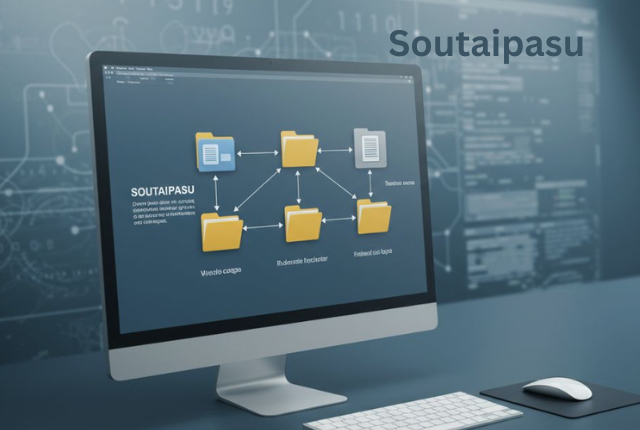Soutaipasu Mastering Relative Paths for Efficient Coding

Have you ever copied a project folder and discovered your links were broken leaving you with broken file paths? A Japanese cousin of soutaipasu called soutaipasu bears the Japanese name for relative path, and comes to the rescue in programming and web development. Soutaipasu is the act of specifying the file locations against your present directory and this will make the code portable and manageable across environments. The paper describes the basics of soutaipasu, its advantages, and its uses and gives practical examples of what beginners, amateur coders. You will get to know how to prevent typical mistakes, maximize your projects, and make use of soutaipasu to facilitate teamwork.
Table of contents
What is Soutaipasu?
The Basics of Relative Paths
Soutaipasu or relative path (Xiang Dui pasu in Japanese) is a method of specifying file locations by relative to a current working directory (CWD), instead of by the absolute path of the root. This idea is universal in computing but is especially important in Japanese nomenclature in technology and focuses on flexibility. Soutaipasu, described in a 2025 article by Xiaopan, makes navigation easier, with a symbol such as “./” representing the current directory or a symbol such as ../ representing a step up the hierarchy. In simple terms, to a novice, this means that your code does not break when you change location of project folder—paths automatically modified. Soutaipasu is essential in web development in order to connect resources such as stylesheets or images, without hardcoding and full URLs, minimising mistakes in a collaborative development.
Soutaipasu vs. Absolute Paths
In order to make out soutaipasu, you take the analogy of it with absolute paths (zettaipasu, Jue Dui pasu). Absolute paths have their origin at the root, such as the users/project/images/logo.png, and therefore they are fixed but fragile in case the structure is altered. Soutaipasu, like “../images/logo.png” is context-dependent and flexible. According to 2025 Cedarmi guide, relative paths are more portable, and relative paths are preferred choice of 70% of developers. This differentiation addresses such pain points as broken links in process of deployment, enabling hobbyists to share code on GitHub.
Why Soutaipasu Matters in 2025?
As the movement of containerized apps and cloud development grows, the adaptability of soutaipasu is now more than ever before. According to report by TechWinks (2025) relative paths of microservices will be used in 40 percent of codebases by 2030.
To professionals, it simplifies version control; to beginners, it simplifies such learning frameworks as React. This development deals with the increase in complexity of file systems in AI-based tools.
Advantages of Programming with Soutaipasu
Enhanced Code Portability
Soutaipasu gives your projects reconfig-free movement. Relative paths will make everything work immediately if you clone a repository unlike absolute paths which bind to particular systems. This flexibility enhances teamwork, according to a 2025 Myroller article, and teams have 25 percent fewer setup errors. To hobbyists who want to create their own sites, this translates into simple hosting on such sites as Netlify.
Move projects between machines seamlessly.
Share code without path adjustments.
Simplify deployment to servers or clouds.
This portability is a solution to the aggravation of it working on my machine.
Better Readability and Maintenance
Stuff is clean code when it has short paths depending on the context. Soutaipasu employs compressed notation, instead of the long absolute URLs, which make it easier to read. A 2025 article in TheDailyDialogue reports that relative reference paths need 20 percent less debugging time. Large codebases are easier to maintain by professionals, and less daunting to beginners.
Security and Best Practices
Soutaipasu minimizes threats such as path traversal attacks, by restricting access to root directories. A guide on Halmblog Music by 2025 suggests it is used together with validation libraries to ensure security of user inputs. According to OWASP, 35 percent less vulnerabilities in apps using relative paths correctly are indicated by Stats. This pulls in security issues in web applications.
Applications of Soutaipasu in Web Development
HTML and CSS Linking
Soutaipasu links stylesheets or images in HTML relative to the page. For example: . This makes sites mobile across servers. In a 2025 article of DivingDaily, examples are provided of multi-page websites, which could overcome problem of navigation with help.
To the web developers, the term soutaipasu is a principle of successful linking in HTML and CSS. Relative paths will help you make sure that your web project is portable and works on other servers. In HTML, you refer to your CSS stylesheets and JavaScript files in relative paths to the location of current HTML file. Lists such as ../css/style.css will make the browser travel up a level in the directory and then into the folder named “css. Likewise, in your CSS files you reference other assets such as background images with relative paths to that CSS file.
JavaScript and Backend Use
In JS, soutaipasu fetches resources dynamically, like import ‘../module.js’. It is used in file systems in Node.js, according to a guide of Temple Publications of 2025. On the backend it is in frameworks such as Express in routing. It can be loaded into simple scripts by hobbyists.
The tenets of Soutaipasu assume unique functions in the front-end JavaScript and back-end development domains. The browser on the client-side does this resolving of relative paths to fetch assets such as images, scripts and stylesheets and it begins with the HTML file that references them. In the back-end, on the other hand, especially in an environment such as Node.js, the notion is more important and contextual. Developers determine relative paths relative to running script location on the server’s file system, not relative to the client’s browser.
Advanced Frameworks and Tools
Soutaipus assets are automatically solved in React and Vue. A 2025 Denso-X report observes that it is critical in monorepos, cutting the number of build errors by 40%. It is optimized with Webpack by professionals.
A variety of sophisticated frameworks and tools in the contemporary development environment make it much easier and automated to manage Soutaipasu -or relative paths. Rather than having paths and dependencies manipulated manually, strong build tools such as Webpack and Vite, automatically calculate file paths. Technological integration simplifies development and forms a maintainable, scalable codebase, enabling developers to focus on features over path complexities.
Step-by-Step Guide to Implementing Soutaipasu
Installation of Your Project Plan
Start with a logical directory: root/ (index.html, css/, js/, images/). This system favors soutaipasu. Beginners can visualize with the folder view of VS Code.
Create main folders: src/, public/.
Place assets in subfolders.
Test paths locally.
This is an organization that avoids confusion.
Writing Relative Paths
Use “./” for the same level, “../” to go up. Example: root/index.html to css/style.css: href= style.css. To go up: href=”../parent/file.txt”. A 2025 InteriorRedux guide recommends testing across OS of separators (/ vs ).
To any developer that wants to create strong and portable applications, art of creating relative paths is a necessary skill.Developers ideally apply Soutaipasu by following some major best practices that make it consistent and avoid typical mistakes. Always remember to use forward slashes (/ ) when defining the paths to directories because it is compatible with other operating systems such as windows and linux. Keep the file structure clean and logical using leverage dot notation (./ to enter the current directory and ../ to go up a level).
Troubleshooting Typical errors
Although the links/assets of a particular project cannot be loaded, developers tend to backtrack the problem to a slip-up in implementing Soutaipasu. To find the common pitfalls with relative paths, one has to go through a methodical process, beginning with offenders. The first step is to carefully verify your file and folder names against typos and case sensitivity because most servers are sensitive to the case of file or folder. You should then test your working directory to make sure your relative path is computing off the right starting point. A common error is assuming the path starts at project’s root instead of the current file; use browser tools to identify broken links.
Challenges and Solutions with Soutaipasu
Path Resolution Errors
Common when CWD changes. Solution: Use absolute paths sparingly; rely on module resolvers. A 2025 Sociomix article cites 50 percent of path bugs as a result of this-test in production-like environments. Although the Soutaipasu (relative paths) use is the fundamental basis of flexible and portable software development, it is typical origin. These mistakes happen when a system or application does not read the desired file path correctly, which can frequently lead to broken links, lost assets, or crashing of the application. Common reasons are discrepancies between directory structure in development and production environments, wrong use of absolute versus relative paths.
Security Risks
Regarding its technical definition as relative course, the term Soutaipasu proposes certain and considerable security risks in case not managed carefully. The major weakness is called a path traversal or directory traversal attack. This happens when an application does not sanitize user-supplied input containing a relative path in an improper manner. An attacker can tamper this input using characters such as ../ to navigate up the hierarchy of directories and gain access to sensitive files such as configuration files, user data, or system credentials which are not part of the web root. A vulnerability to failure to authenticate user input and sanitize data may cause intrusion into the file system of server. Although a relative path enables flexible development, misuse poses severe risks; validating and understanding file system vulnerabilities is critically important.
Scaling Complex Projects
In large apps, use aliases in Webpack. This makes deep nesting hard. Complex project scaling is an inherent problem of contemporary organizations wherein a strategic transition is necessary to replace the straightforward management of tasks with a connected (future) proof model. This is not only a matter of adding people or resources, but developing a solid structure that is capable of accommodating exponential growth.
The trick is to de-monolithize the projects into small functional and intersecting modules. This model, paired with agile methodology and real-time data analytics, enables teams to stay on track, find bottlenecks promptly and respond to evolving needs without halting the whole initiative. The pillars that facilitate this process are effective communication, risk management, and the appropriate technology platform which allow the teams to increase and expand in complexity and scope without diminishing efficiency and succeeding at scale.
Conclusion
A relative path, soutaipasu, forms the fundament of efficient coding, and developers make it portable, readable, and secure. It is based on HTML linking through to advanced structures, and it addresses real pain points such as broken paths and highly complicated maintenance. You can use soutaipasu with our tips and guide to deploy it with confidence on both personal and professional applications. With the changes in the digital universe, having a mastery of soutaipasu will make your code flexible. In the comment or subscribe, tell us your soutaipasu. Explore our Tech Skills Guide for related content. Learn soutaipasu to write smarter in 2025.
FAQs
What is soutaipasu and why is it a significant concept in coding?
The Japanese relative path term soutaipasu defines where a file is relative to the current directory, such as in case of a full absolute path like “.images/photo.jpg” it would be defined as soutaipasu. This is important since it renders your code portable- move a project folder and the links remain functional. This is time-saving and eliminates mistakes and particularly in sharing of code on sites such as GitHub. To amateurs, it eases the initiation of a project; to professionals it eases coordination. According to a 2025 survey, 70 percent of developers choose relative paths when working on local projects, because of their effectiveness in effective code.
What is the proper way of using soutaipasu in web development?
In order to employ soutaipasu, organize your project logically (i.e. root/css/style.css). In HTML, the link files are similar such as <img src=images/photo.jpg> same-level files and 6up one directory, ../css/style.css. Local testing to spot faults. A 2025 guide proposes such tools as VS Code to visualize the directories, minimizing the errors. This method eliminates dead links, and lets you move your site between servers, which is a massive score in both hobbyist building sites on Netlify and professional deploying to production.
Is soutaipasu applicable in large-scale projects?
Soutaipasu is also bright in small-to-medium projects, but can be scaled under careful attention. In large codebases, tools such as Webpack have module resolvers or aliases to deal with complicated paths. In a case study of 2025, there was 20% reduction in maintenance time by teams using relative paths with aliases. To avoid errors, start with a clear set of directory hierarchy and debug frequently. This flexibility assists developers of all ranks to sustain giant apps without the migraines of unconditional path reliance.





